An overview of simulators
Published date : 10 December 2008
Article date : 10 December 2008
Introduction
A summary of the subjective opinions of Interventional Radiologists regarding selected medical simulations by WE Lewandowski and DA Gould.
This article aims to reflect the subjective opinions of Interventional Radiologists regarding the ability of medical simulators, manufactured by three different vendors, to replicate key procedural tasks in the carotid, contralateral iliac and renal arteries. The data obtained also provides feedback to the medical simulation industry on the opinions of Interventional Radiologists as to the realism and fidelity of aspects of the carotid, contralateral iliac and renal procedures in the various simulators. It is important to note that the data discussed in this article was collected during the period September – November 2006, and thus represents a snapshot in time regarding the capabilities of the various simulations discussed below. The authors are aware that all of the simulation manufactures have modified their products since the data was originally collected.
Background
Simulations of varying degrees of effectiveness have been developed to support training for a large number of medical specialties from anesthesiology to urethroscopy. Interventional Radiology is no exception with still-evolving simulations available from vendors in carotid, iliac and renal procedures. A critical factor in these simulations is presentation to the operator of visual cues in a virtual fluoroscopic image, challenging the operator’s decision making and procedural sequencing. Tactile cues are also perceived via a human-computer interface device which aims to replicate the subtle feel transmitted through guide wires, catheters, and other interventional devices in patients. Yet little is known about these low level cues and their importance in the many procedural steps that are performed automatically by the experienced operator.A number of studies and papers have been presented in medical literature and society meetings analyzing the various aspects of medical simulation including efficacy, transfer of training and validation (1-8). In our opinion, however, what has not been done is to provide practical information to the Interventional Radiology community that would be immediately useful in the decision process as to how to integrate medical simulation into curricula.
By definition, a simulation is not reality; it is an imperfect reflection. While modern technology has made amazing advances in its ability to replicate complex aspects of reality such as tissue deformation, fluid dynamics and touch (9), at least for the foreseeable future, the fidelity of sensory reproduction in medical simulation will not be the equivalent of sensory experience in reality. Because of this, there will be some aspects of a simulated procedure that will be less than acceptable for training. Conversely, there will be other aspects of the procedure that will be considered adequate.
In this study (September – November 2006) we relate aspects of the medical simulation experience that have been considered by subject matter experts (SME) to be acceptable in simulators manufactured by three different vendors (10-12). There follows a description of each of these simulators as they existed during the period September to November 2006.
CathLabVR™
CathLabVR™The CathLabVR™ Surgical Simulator (formerly the Endovascular AccuTouch® System: Immersion Medical, Gaithersburg, UA) is claimed to demonstrate capability to “allow clinicians to practice coronary, carotid and peripheral vascular interventions, cardiac pacing, and cardiac valve replacements. The CathLabVR virtual reality system, which simulates the look and feel of actual surgeries, helps clinicians to develop skills prior to performing on patients and to maintain those skills throughout their professional practice” (10). At the time of this study, the CathLab simulation we used demonstrated a range of cases scenarios in one anatomical region, the Carotid artery, in support of Interventional Radiology, carotid stent training.
Procedicus VIST – Radiology simulator
Procedicus VISTTM – Radiology simulatorMentice, a Swedish-based medical simulation company, manufactures an endovascular simulator called the Procedicus VISTTM – Radiology simulator. At the time of the study (September – November 2006), Carotid, Iliac and Renal simulations were available to support Interventional Radiology.
The VIST system claims: “highly realistic simulation based training of renal, carotid and iliac stenting using realistic 3D patient anatomies, real nested tools, tactile feedback, different cases /scenarios and complications. The Procedicus VISTTM system consists of an interface device, a computer and two displays - one for the fluoroscopic image and one for the instructional system. The interface device is the virtual patient, with an introducer in place. Through this, the different real life tools and devices can be introduced - actual tools are used (and are re-used). All tools are active and can be manipulated at any time in the procedure. The interface and the tools (catheters, balloons, guide wires, etc.) interact with the simulation through a software package generating the fluoroscopic display, the forces that are reflected in the tools (for tactile feedback), the contrast flow, hemodynamics and the results of the simulated intervention. The web based user interface guides the user through the procedure and facilitates for self-learning” (11).
ANGIO Mentor™ simulator
Simbionix is a US-based medical simulation company that manufactures an endovascular simulator called the ANGIO Mentor™ simulator. At the time of the study (September – November 2006), it had Carotid, Iliac and Renal simulations to support Interventional Radiology.
For the ANGIO Mentor™, Simbionix claims that it is designed “ … to enhance skills across the range of invasive percutaneous cardio/endovascular techniques, including diagnostic angiography, angioplasty intervention, administering thrombolytic agents, and capabilities for recognition and management of developing complications. The use of the ANGIO Mentor™ simulator by interventional cardiologists and radiologists results in a higher level of professional skills, allowing them to provide patients with better care”(12).
Clinical findings/procedure details
This proposal has been part funded by a grant from CIRSE Foundation and commenced with an abbreviated task analysis for each of the target procedures. The procedural task analyses were then sent to representatives of each of the simulator manufacturers for their concurrence that the task analyses reasonably reflected those aspects of the target procedures the various simulators were designed to simulate. Next, the task analyses were sent to Interventional Radiologists, recommended by CIRSE, for review. The final task analyses were then combined with questions on respondents’ biographical backgrounds and converted into a survey. The draft surveys were then sent to the CIRSE review panel for final concurrence.
The survey was primarily conducted at the September 2006 CIRSE meeting in Italy, and then again at the smaller November 2006 BSIR meeting in England. These meetings were chosen to take advantage of the wide range of Interventional Radiologists in attendance. At both of those meetings, the medical simulation vendors had been invited to set up their devices in an area set-aside for that purpose (Immersion Medical was not present at BSIR). Meeting attendees were requested to use the various simulators, dependent on the time available, and to then complete the surveys. An area was designated to return completed surveys.
Respondents were self-selecting, and free to use any, or all, of the simulators as often as they desired: no effort was made to control the actions of the respondents and not every respondent chose to review all three simulators. During their use of each simulator, they were assisted either by a vendor’s technical supporter or by another conference attendee.
The completed surveys were collected, collated and analyzed by the authors. The survey is reproduced below with the participants’ collated responses, embedded. Black text represents the survey itself as seen by the participants. The various colored graphs, and the red text are the collective responses. Where comments were provided by the respondents, they have been recoded here without editing.
SURVEY (WITH RESULTS) DISTRIBUTED AT CIRSE CONFERENCE SEPTEMBER 2006 AND BSIR NOVEMBER 2006
General Biographical Information (26 respondents)
1. Years in Interventional Radiology (or other interventional) Practice?
Median 13 years +/- 9.23
2. Age? _
Median 45 years +/- 8.46
3. What is your gender?
Male = 24, Female = 2.
4. In what country or countries are you licensed to practice medicine?

5. How would you describe your level of experience with the use of computers?
Very experienced: 42%
Somewhat experienced: 58%
6. Have you used a medical simulator in any type of training program?
Yes: 15
No: 11
If you have answered “Yes” please provide details:
‘Previous Simulation [?]’
‘During the French annual congress. During a renal interventional procedure training.’
‘Guidant JFR 2003’
‘Clinical decision making in trauma patients (theoretical simulation).’
‘In a Cordis training program’
‘STUD+, DATS, Congress’
‘Guidant renal simulation in Brussels’
‘Saw and tried a surgical model. Carotid stent Mentice.’
‘Mentice, Simbionix, MSC and Immersion’
7. In the chart below, please write in the year you started performing the indicated procedures:
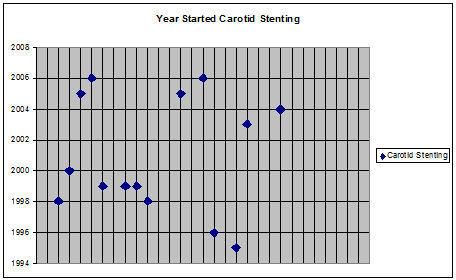
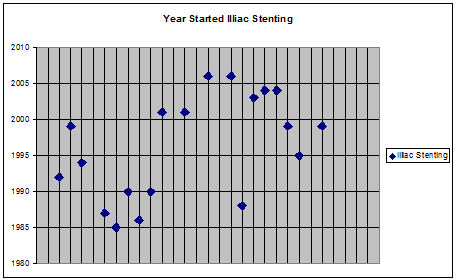
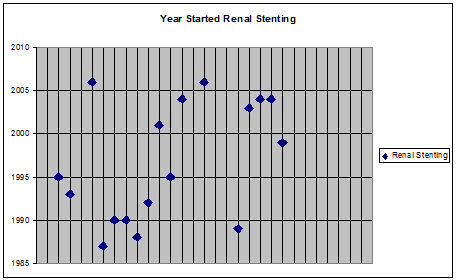
8. In the chart below, please indicate when you trained to perform the following procedures:
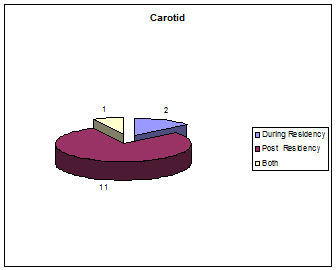
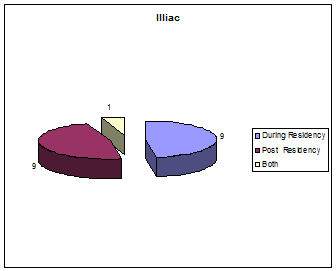
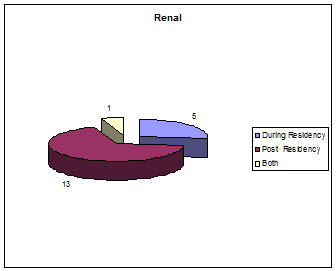
9. In the chart below, please indicate how many of the following procedures you perform in a year:
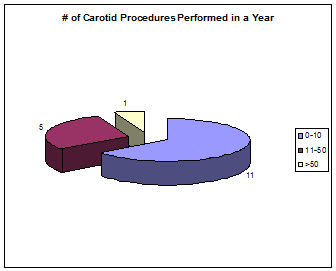
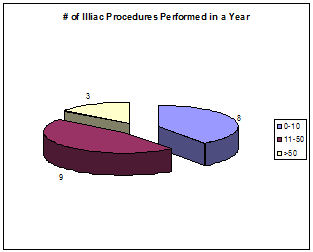
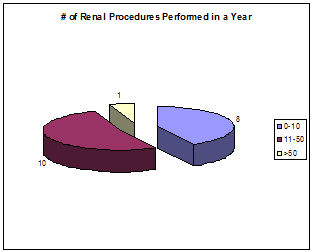
Carotid Procedure – The Immersion Medical Simulation
10. The tasks below are those generally associated with performing a Carotid Procedure. Please indicate the degree to which you either agree or disagree that the Immersion Medical simulator realistically simulates a particular task by circling the appropriate number (1= strongly disagree; 2= somewhat disagree; 3= acceptable; 4= somewhat agree; 5= strongly agree). If you feel that a given task is not simulated at all, please circle “NA”.
Comments:
“Has complications - good. Has adjunct drugs - good. Stable machine.”
“Not very realistic. Doesn't exchange guidewires, catheters only pull back 10-20 cm. Uses same catheters/guidewires[?] realism of exchanging.”
“The machine crashed during the procedure.”
Carotid Procedure – The Mentice Simulation
11. The tasks below are those generally associated with performing a Carotid Procedure. Please indicate the degree to which you either agree or disagree that the Mentice simulator realistically simulates a particular task by circling the appropriate number (1= strongly disagree; 2= somewhat disagree; 3= acceptable; 4= somewhat agree; 5= strongly agree). If you feel that a given task is not simulated at all, please circle “NA”.
Comments:
“Mentice simulation vessels look less than Simbionix. Spontaneous catheter movements in desc. Aorta without manipulation. Report after procedure less than Simbionix. Auto centering option is great feature.”
Contralateral Iliac Procedure – The Mentice Simulation
12. The tasks below are those generally associated with performing an Iliac Procedure. Please indicate the degree to which you either agree or disagree that the Mentice simulator realistically simulates a particular task by circling the appropriate number (1= strongly disagree; 2= somewhat disagree; 3= acceptable; 4= somewhat agree; 5= strongly agree). If you feel that a given task is not simulated at all, please circle “NA”.
Comments
“Wire too long. Makes exchanges awkward and unrealistic.”
“Face validity issues. Air in syringe. Stiff wire end.”
Renal Procedure – The Mentice Simulation
13. The tasks below are those generally associated with performing a Renal Procedure. Please indicate the degree to which you either agree or disagree that the Mentice simulator realistically simulates a particular task by circling the appropriate number (1= strongly disagree; 2= somewhat disagree; 3= acceptable; 4= somewhat agree; 5= strongly agree). If you feel that a given task is not simulated at all, please circle “NA”.
Comments:
“Good sensations but sometimes a too important moving of the catheter not the stent despite a gentle push through.”
“Every diagnostic aspect of the procedure is realistic. The intervention part maybe emphasize a little bit too much the tricky part (i.e. stent sliding forward or backward. The manual feeling is rather realistically rendered. Good tool to help student to understand the preliminary explanation. Very favorable opinion.”
“Have not done renal stent procedure so my comments about realism should be guarded. Excellent idea to get familiarity with tasks. Not perfect for feel of wire.”
Carotid Procedure – The Simbionix Simulation
14. The tasks below are those generally associated with performing a Carotid Procedure. Please indicate the degree to which you either agree or disagree that the Simbionix simulator realistically simulates a particular task by circling the appropriate number (1= strongly disagree; 2= somewhat disagree; 3= acceptable; 4= somewhat agree; 5= strongly agree). If you feel that a given task is not simulated at all, please circle “NA”.
“Procedure should also include realistic exchange of wires. Software not yet "stable" (two lock ups).”
“Very easy exchange device. Good ? Can give drugs. Has complications. Excellent report.”
“Choice of devices is limited. I did not find the catheters/stents I use. But on the whole a very sophisticated and advanced system. I liked the additional medical [?] (drugs, vital signs, etc.) The patients [?]”
“Not bad”
Contralateral Iliac Procedure – The Simbionix Simulation
15. The tasks below are those generally associated with performing an Iliac Procedure. Please indicate the degree to which you either agree or disagree that the Simbionix simulator realistically simulates a particular task by circling the appropriate number (1= strongly disagree; 2= somewhat disagree; 3= acceptable; 4= somewhat agree; 5= strongly agree). If you feel that a given task is not simulated at all, please circle “NA”.
Comments
None
Renal Procedure – The Simbionix Simulation
16. The tasks below are those generally associated with performing a Renal Procedure. Please indicate the degree to which you either agree or disagree that the Simbionix simulator realistically simulates a particular task by circling the appropriate number (1= strongly disagree; 2= somewhat disagree; 3= acceptable; 4= somewhat agree; 5= strongly agree). If you feel that a given task is not simulated at all, please circle “NA”.
Comments:
“Not bad”
“A not good machine with [?] helping people.”
Conclusions
42% of the respondents reported that they had previously used a simulator in a training program, a higher proportion than we had expected. It was also informative that a significant percentage of respondents reported that they performed less than 10 of the targeted procedures per year.
In the task analysis, respondents tended to feel that those aspects of the simulation which were mostly based on cognitive skills (i.e. rules, concepts, discriminations and decision making) were simulated to an acceptable level, while those requiring fine motor skills and response to subtle changes in touch and pressure tended to be scored to a lower level of acceptability. This varied non-significantly between simulators but confirmed our expectations as to respondent’s views on fine motor actions.
As the reader reviews the results of this study, it is important to remember that this is a “snapshot” in time. It is expected that, since this study was conducted, the characteristics and capabilities of the various simulators have changed. It is also important to note the circumstances under which the survey was conducted. Medical conferences tend to be hectic affairs in which focus and concentration are very limited. On the other had, we do feel that there is some value in impressions that are gained without extensive processing.
It is our hope that the data we have presented will be useful in helping institutions to identify how the subject medical simulators might be useful as tools for teaching selected procedural aspects of Interventional Radiology in resident and fellowship programs. We feel that even though the functionality and capabilities of the simulators used in this study has changed, the data still has relevance since a number of institutions own the type and model of devices that were used in this study. In addition, we feel that the study can serve as a useful guide for evaluating current and future simulation devices. The format we use allows the reader to look at specific, key procedural tasks and review the grading of relative effectiveness of a particular simulator to realistically replicate a given task. We also feel, that it provides some valuable information back to the vendors as to what aspects of their simulation they may want to improve.
The fact that the respondents tended to feel that the simulators were not as realistic in simulating fine motor skills, as they were in simulating cognitive skills, should not be construed in too negative a light. As important as the fine motor skills are, the cognitive skills are equally a part of the procedures and are thus equally important. They too must be mastered to be able to successfully perform a procedure. Perhaps the conclusion that should be drawn is that for the cognitive skills the various simulators might be relied upon as important training devices, but at least for the specific model of simulators used in this study, this might not be the case for acquisition and perfection of fine motor skills. While residents might be taught the procedural steps of these motor skills using a simulator, other means probably have to be relied upon in order to complete the learning process. These other means rely, for now, on mentored training in patients within apprenticeship training programs.
References
1. Dankeman J., M.K. Chmarra, E.G.G. Verdaasdonk, L.P.S. Stassen, C.A. Grimbergen. Fundamental aspects of learning minimally invasive surgical skills - Review. Minimally invasive Therapy and Allied Technologies, 2005; 14: 247-256.2. Gallagher AG, Ritter M, Champion H et al. Virtual reality simulation for the operating room: proficiency based training as a paradigm shift in surgical skills training. Annals of Surgery, 2005; 241:364-372
3. Gould DA, Reekers JA, Kessel DO, Chalmers NC, Sapoval M, Patel AA et al., CIRSE. Simulation devices in interventional radiology: caveat emptor. Cardiovasc Intervent Radiol 2006 Jan-Feb;29(1):4-6.
4. Gould DA, Kessel DO, Healey AE, Johnson SJ, Lewandowski WE. Simulators in catheter based interventional radiology: training or computer games? Clin Radiol 2006;61:556-561.
5. Agarwal R, Black SA, Hance JR, Darzi A, Cheshire NJW. Virtual reality simulation can improve inexperienced surgeon’s endovascular skills. Eur J Endovasc Surg 2006;31:588-593.
6. Letter / comment: D Kessel, D Gould, W Lewandowski. Virtual Reality Simulation Training can Improve Inexperienced Surgeons’ Endovascular Skills. Eur J Vasc Endovasc Surg (Vol 33) Feb 2007: p259.
7. Hsu JH, Younan D, Pandalai S, Gillespie BT, Jain RA, Schippert DW et al. Use of computer simulation for determining endovascular skill levels in a carotid stenting model. J Vasc Surg 2004;40(6):1118e1124.
8. Dayal R, Faries PL, Lin SC, Bernheim J, Hollenbeck S, Derubertis B et al. Computer simulation as a component of catheter based training. J Vasc Surg 2004;40(6):1112e1117.
9. F. P. Vidal, F. Bello, K. W. Brodlie, D. A. Gould, N. W. John, R. Phillips, and N. J. Avis. Principles and Applications of Computer Graphics in Medicine. Computer Graphics Forum, Blackwell, 25(1):113–137, 2006.
10. Immersion Medical, Endovascular AccuTouch Simulator website: http://www.immersion.com/medical/products/endovascular/index.php. (accessed 24 June 2007).
11. Mentice Procedicus VIST-Radiology. Carotid and Renal stenting: website. http://www.mentice.com/. (accessed 24 June 2007).
12. Simbionix: ANGIOMentor: website. http://www.simbionix.com/ANGIO_Mentor.html. (accessed 24 June 2007).


